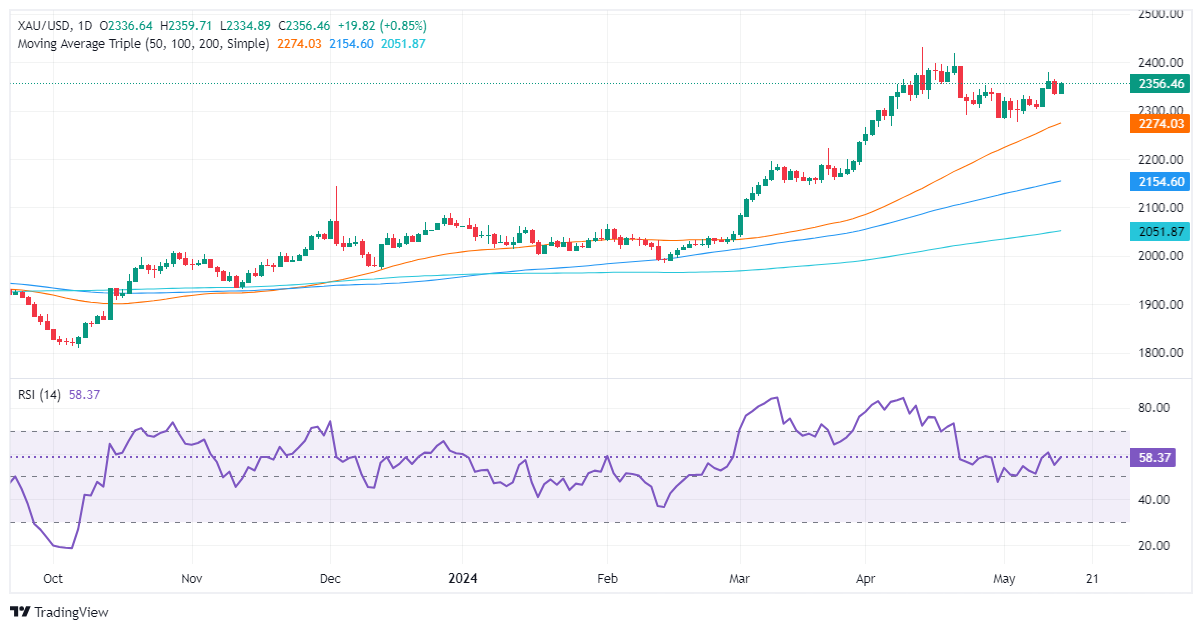- Gold jumps 0.97% after US producer price data shows higher-than-expected inflation.
- Despite a spike, Treasury yields reversed to 4.445%, weakening Greenback and boosting Gold.
- Powell’s waning confidence in disinflation and optimistic GDP outlook of 2% or more fuel Gold’s rise.
Gold prices climbed past the $2,359 figure on Tuesday after data released by the US Department of Labor revealed that factory gate inflation rose above estimates, signaling that prices remained elevated. Despite that, US Treasury yields are sliding, a headwind for the Greenback.
Federal Reserve (Fed) Chair Jerome Powell made headlines after the release of the Producer Price Index (PPI). He commented that he expects inflation to continue heading lower but wasn’t as confident about the disinflation outlook as he had previously been. He added that the Gross Domestic Product (GDP) is expected to grow by 2% or better due to the labor market’s strength.
The XAU/USD trades at $2,359, up 0.97%. The US Bureau of Labor Statistics (BLS) revealed that prices paid by producers increased above estimates, with just one reading aligning with economists’ consensus. US Treasury yields jumped sharply toward a daily high of 4.534%, before reversing later.
Daily digest market movers: Gold bright amid falling US yields, soft US Dollar
- Gold prices fell amid lower US Treasury yields and a strong US Dollar. The US 10-year Treasury note yields 4.451% and is down nearly 4 basis points (bps) from its opening level. The US Dollar Index (DXY), which tracks the Greenback’s performance against six other currencies, falls 0.20% to 105.00.
- The US Bureau of Labor Statistics (BLS) reported that the Producer Price Index (PPI) increased by 0.5% MoM, surpassing the forecasted 0.3% rise. Similarly, the core PPI, which excludes food and energy prices, also rose by 0.5%, beating the expected 0.2% increase. Both figures were significantly higher than March’s decline of 0.1% in both general and underlying inflation, indicating a jump in producer prices.
- April’s Consumer Price Index (CPI) is projected to remain unchanged compared to March’s reading at 0.4% MoM. The core CPI is expected to resume its lower trend from 0.4% in March to 0.3% MoM.
- Further data will be featured during the week, led by Retail Sales on May 15, Initial Jobless Claims, and Industrial Production on May 16.
- The New York Federal Reserve released its monthly Survey of Consumer Expectations on Monday, showing that the year’s inflation expectations increased to 3.3% vs. 3% in March. The data came after the University of Michigan Consumer Sentiment poll showed that inflation expectations for a one-year outlook rose from 3.2% to 3.5%.
- Interest rate cut expectations toward the end of the year remain at 35 basis points (bps), according to data provided by the Chicago Board of Trade (CBOT).
Technical analysis: Gold price surge above $2,350 with bulls eyeing $2,400

Gold’s uptrend extended after posting losses on Monday, yet it remains below the latest cycle high of $2,378, seen on May 10. This could keep the XAU/USD range bound. According to readings of the Relative Strength Index (RSI), momentum is in favor of the bulls.
Therefore, the XAU/USD first resistance would be the May 10 high at $2,378. If broken, the next technical hurdle would be the psychological $2,400 mark, immediately followed by the April 19 high at $2,417, and the all-time high at $2,431.
Conversely, if sellers moved in and pushed prices below $2,359, that could sponsor a leg down toward the May 9 low of $2,306, followed by the $2,300 figure. Once surpassed, the next stop would be the 50-day Simple Moving Average (SMA) at $2,249.
Fed FAQs
Monetary policy in the US is shaped by the Federal Reserve (Fed). The Fed has two mandates: to achieve price stability and foster full employment. Its primary tool to achieve these goals is by adjusting interest rates. When prices are rising too quickly and inflation is above the Fed’s 2% target, it raises interest rates, increasing borrowing costs throughout the economy. This results in a stronger US Dollar (USD) as it makes the US a more attractive place for international investors to park their money. When inflation falls below 2% or the Unemployment Rate is too high, the Fed may lower interest rates to encourage borrowing, which weighs on the Greenback.
The Federal Reserve (Fed) holds eight policy meetings a year, where the Federal Open Market Committee (FOMC) assesses economic conditions and makes monetary policy decisions. The FOMC is attended by twelve Fed officials – the seven members of the Board of Governors, the president of the Federal Reserve Bank of New York, and four of the remaining eleven regional Reserve Bank presidents, who serve one-year terms on a rotating basis.
In extreme situations, the Federal Reserve may resort to a policy named Quantitative Easing (QE). QE is the process by which the Fed substantially increases the flow of credit in a stuck financial system. It is a non-standard policy measure used during crises or when inflation is extremely low. It was the Fed’s weapon of choice during the Great Financial Crisis in 2008. It involves the Fed printing more Dollars and using them to buy high grade bonds from financial institutions. QE usually weakens the US Dollar.
Quantitative tightening (QT) is the reverse process of QE, whereby the Federal Reserve stops buying bonds from financial institutions and does not reinvest the principal from the bonds it holds maturing, to purchase new bonds. It is usually positive for the value of the US Dollar.

























